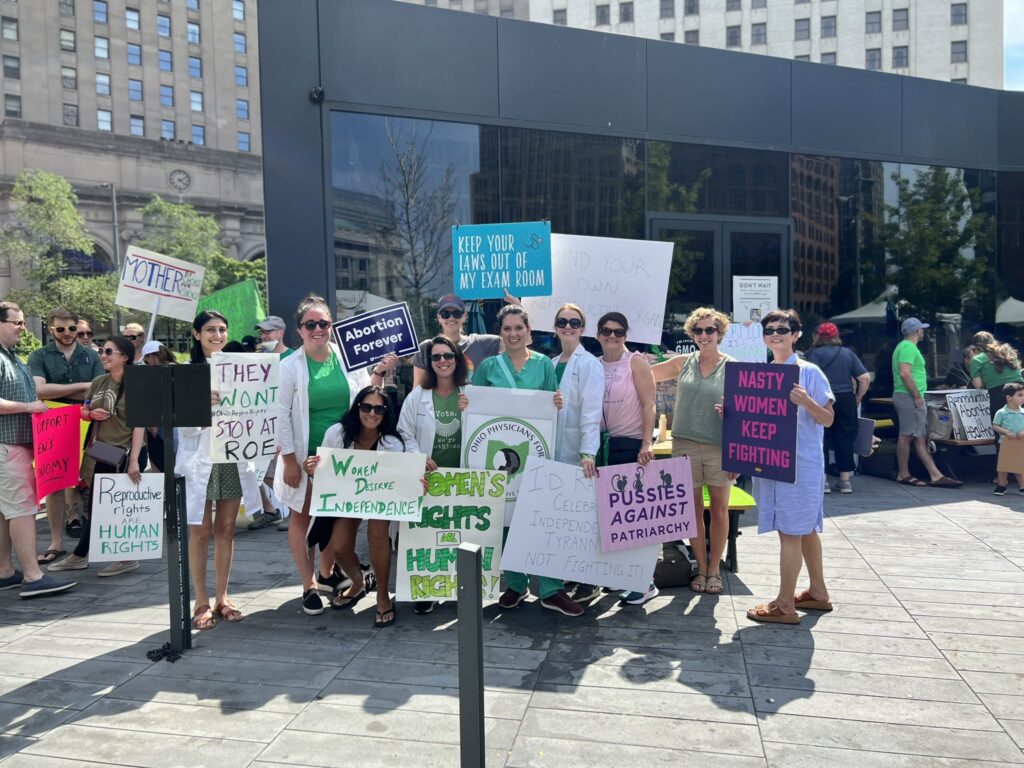In the next battleground state on abortion, activists win the first round in an effort to safeguard abortion rights.

Proponents of the ballot measure to amend Ohio’s state constitution to protect the right to abortion always knew they faced an uphill battle.
Yet they were energized by what voters accomplished in Kansas in summer 2022 and what they gained in California, Vermont, Montana, Michigan and to a small extent in Kentucky a few months later in the midterms. In fact, every effort to protect the right to abortion—or to enshrine the right in the state constitution—was successful, and by respectable margins.
Spearheaded by Ohio Physicians for Reproductive Rights, they mounted a successful grassroots campaign; garnered endorsements from a diverse, broad-based coalition; amassed thousands of volunteers; and successfully gathered 710,000 valid signatures—far more than the required number.
Lauren Blauvelt, a member of the executive committee of Ohioans United for Reproductive Rights and a vice president at Planned Parenthood Advocates of Ohio, said getting the necessary signatures to place the abortion amendment on the November 2023 ballot was a huge grassroots-led effort, and it showed that Ohioans want the opportunity to vote to protect abortion access and reproductive freedom.
We have to be successful here so we can carry the torch for the next group of states who are trying to do this in 2024.
Dr. Lauren Beene, executive director, Ohio Physicians for Reproductive Rights
“We had organizations—large and small—from around the state reaching out to their members about wanting to do a citizen-led ballot initiative,” Blauvelt told Ms. “So we were able to use that energy and momentum to really invest in the research and the polling to help craft the language … which made it through the [state] attorney general and the ballot board more quickly than anticipated.”
However, abortion-rights advocates were not just challenged to get valid signatures quickly enough to qualify the measure for the 2023 general election; they also had to face another obstacle. The GOP-dominated legislature, determined to thwart all efforts to guarantee abortion access in Ohio, moved just as quickly to try to change the rules, devising a ballot measure to make it more difficult for voters to amend the state constitution: Instead of the 50-percent-plus-one vote requirement (a simple majority), any future citizen-led initiative would require a 60 percent supermajority to pass.
Taking it one step further, Republican lawmakers voted to place this rule change, known as Issue 1, on the ballot in an election scheduled for Aug. 8—so that the new requirement would be in place when Ohio votes on the abortion-rights amendment. The abortion amendment’s fate now hinged on first defeating Issue 1 in an off-year special election expected to have low voter turnout.
But abortion-rights advocates pledged to meet both challenges. They campaigned strongly against Issue 1, and by a 14-point margin Ohio voters defeated the rules-change measure‚ meaning the abortion-rights amendment can pass with a simple majority.
At the same time, polling data leaned heavily in the amendment’s favor: According to a USA Today Network/Suffolk University poll, about 58 percent of Ohioans support adding the right to abortion to their state constitution, with 32 percent opposed and 10 percent undecided.


This story originally appeared in the Fall 2023 issue of Ms. magazine. Join the Ms. community today and you’ll get the Fall issue delivered straight to your mailbox.
Winning will not be easy. But losing is not an option, said Dr. Lauren Beene, executive director of Ohio Physicians for Reproductive Rights.
“Based on what I have seen in Ohio, and how I know that Ohioans are in support of not having the government making their medical decisions for them … and having the right to access abortion, and just the breadth of groups that are in support of this, I believe that we will be successful in November,” she said.
The fight to protect and defend abortion rights and reproductive freedom has been an ongoing legal and political struggle in the Buckeye State.
In 2019, the Ohio legislature passed a six-week abortion ban, outlawing the procedure before many women even know they are pregnant. The law was blocked in federal court pending the 2022 Dobbs decision, which overturned Roe v. Wade. Just hours after the Supreme Court issued its ruling, the six-week ban went into effect.
Abortion-rights advocates quickly filed for emergency relief from the Ohio Supreme Court to block the law, but the Court denied their request. Abortion-rights advocates then took their suit to the trial court in Cincinnati and received a temporary restraining order. Currently a preliminary injunction has the law on hold, and the case has now made its way back to the state Supreme Court.

Jessie Hill, a law professor at Case Western Reserve University in Cleveland, a volunteer attorney for the American Civil Liberties Union and the attorney who argued the case in court against the six-week abortion ban, said it is not likely the Court will rule on the case before voters have the opportunity to make their voices heard on the abortion- rights amendment. Meanwhile, abortion remains legal in Ohio up to 22 weeks of pregnancy.
“My own view is that the judges are going to apply the law. … The reproductive freedom amendment is so clear that there is no question that the six-week ban cannot be enforced if this passes, and the ban becomes null and void,” Hill said.
However, she cautions that the Court’s conservative makeup means it’s difficult to say with certainty how the judges are going to deal with this and future cases, which makes Ohio unique on many fronts.
The reproductive freedom amendment is so clear that there is no question that the six-week ban cannot be enforced if this passes, and the ban becomes null and void.
Jessie Hill, attorney and law professor
“This is the first time [in the post-Dobbs era] that a proactive ballot initiative—one that affirmatively codifies the right to abortion in the state constitution—will pass in a state that has a hostile state government,” Hill said. “The governor, legislature and the [state] Supreme Court are all conservative and anti-abortion.”
Hill also points out that taking issues to the courts is only one avenue for change; she contends that political power building is just as important or more important, and that it has to happen at the state level.
Beene said passing the amendment in this post-Roe climate is a fight Ohio abortion-rights groups have to fight: “We have to be successful here so we can carry the torch for the next group of states who are trying to do this in 2024.”
Read more:





